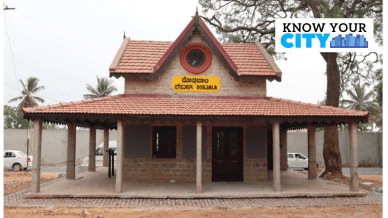Stay updated with the latest - Click here to follow us on Instagram
Know Your City | Looking back at Bangalore-Chikballapur line, a landmark of railway in Mysore state in early 1900s
While public-private partnerships are now common, this railway was perhaps one of the earliest examples of such partnership, having been completed in 1918 in association with the Mysore State Railway.

Bengaluru has long been a hub for rail transportation, with the outlying villages and small towns around the city often relying on the railway network for commutes or other travel. This was no less true before Independence, when the area was under the rule of the princely state of Mysore.
While public-private partnerships are now common, this railway was perhaps one of the earliest examples of such partnership, having been completed in 1918 in association with the Mysore State Railway. Uniquely, several heritage railway stations built at this time are still operational. The original railway on this route operated on a narrow gauge.
Railway expert and former IAS officer T R Raghunandan said the narrow-gauge line used to run until the late 1970s. “These were easier and cheaper to construct and took care of traffic at a time when asphalted roads did not exist. Many of the princely states preferred to have narrow-gauge lines rather than invest in asphalt roads. There was not enough commercial road transport in those days. If you look at the Baroda State Railway and other kingdoms in Saurashtra, there were extensive narrow-gauge lines,” he said. “That was how they served the rural hinterlands. In a sense they were independent countries where local transport was the domain of the Maharajas.”
Raghunandan said the Wadeyars of Mysore also had a connection with the Gaekwads of Baroda. He further noted that the original line, which passed through Nandi via Yelahanka and meandered through Kolar district after passing through Chikballapur, ended in Bangarpet. One or two locomotives that would have run on such lines are on display at the Mysore Railway Museum.
Meanwhile, the restoration of four heritage stations on the route—namely Nandi Halt, Devanahalli, Avatihalli and Doddajala—is underway, with the reconstruction being done by the Indian National Trust for Art and Cultural Heritage (INTACH) and sponsored by Discovery Village, in collaboration with the South Western Railway.
Chetana Hamsagar, a conservation engineer with INTACH, said, “The Avatihalli station is the only one that has brick and lime in construction. The rest are made of stone and mud/lime mortar… The Avatihalli station may have been reconstructed. They all have sloping roofs with tiles and a double-height central hall, with an externally covered verandah and a small room attached, while the station at Nandi Halt is the largest. At Nandi Halt, the structure to the left of the arch would have been added later to the original.”
Hamsagar noted that additions had been made to the heritage structure but using the same material.
Layers of paint also had to be painstakingly removed from the original stone masonry.
While trains still stop at these stations today, stationmasters are likely to arrive some time before the arrival of the trains to distribute tickets, on account of the relatively low number of passengers.